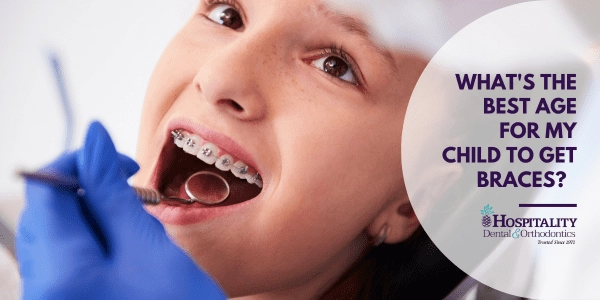
Braces can effectively correct your orthodontic issues at any age, giving you a healthier and straighter smile. But for many, the decision to get braces is often made by parents. Raising a child involves a million decisions, and many parents wonder: “What’s the best age for my child to get braces?”
Getting an Exam
The American Association of Orthodontic Association recommends that children get their first exam at age seven, several years after their first recommended dental appointment, which should happen by their first birthday.
Most kids’ baby teeth will start getting wiggly around six years old. This process starts because their permanent (adult) teeth have started pushing their way down.
By seven, most children will have enough development of their permanent teeth for an orthodontist to spot any serious upcoming problems, like impacted teeth or missing teeth.
As attentive as parents are – these problems can’t always be observed with the naked eye, so an orthodontist will x-ray the child patient to give you a full overview. They may even discover extra teeth. Any of these issues might lead to a recommendation for early treatment.
Early Treatment
The best age for a child to get braces is between ten and fourteen, but sometimes kids have issues that need to be addressed earlier.
Most orthodontists encourage parents to wait until ten or fourteen because younger kids might struggle with fear or anxiety about the treatment.
Sometimes though, misalignments can lead to difficulty biting and chewing, jaw pain, damage to permanent teeth, or speech and breathing problems. In these cases, an orthodontist may determine the best age for a child to get braces is before their tenth birthday.
Typical Treatment
Most children with misaligned smiles should get braces between the ages of ten and fourteen. At this point, their permanent teeth have developed to the point that alignment issues can be identified, and the child’s still-growing jaw can adjust to the newly positioned teeth.
If braces are introduced after a patient’s jaw has stopped growing, treatment might not be possible with braces alone.
When your child gets braces, they can expect the treatment to last one to three years, and to wear a retainer for a prescribed period of time afterward.
While good hygiene habits are important at any age, diligent brushing and flossing is especially necessary while wearing braces, as the equipment gives bacteria extra nooks and crannies to collect and damage teeth and gums.
You’ll also have to discourage them from an excessively sugary diet and to stay away from hard and sticky foods that can bend the wires of the braces. That level of discipline is one of the reasons it’s best to wait until a kid is old enough to understand the importance of being conscientious in the short-term to get the long-term benefits.
Seeing Results
Once teeth are properly aligned, oral hygiene becomes easier. No more struggles getting a brush and floss in between crowded teeth. Your gums are healthier with straight teeth. Some speech impediments are more easily corrected when a bite is improved. And, of course, there are the social and psychological boosts that come from having a smile you can’t wait to share with the world. Health and confidence – what better gifts to hand to your child?
